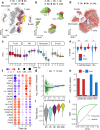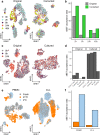Sampling time-dependent artifacts in single-cell genomics studies
- PMID: 32393363
- PMCID: PMC7212672
- DOI: 10.1186/s13059-020-02032-0
Sampling time-dependent artifacts in single-cell genomics studies
Abstract
Robust protocols and automation now enable large-scale single-cell RNA and ATAC sequencing experiments and their application on biobank and clinical cohorts. However, technical biases introduced during sample acquisition can hinder solid, reproducible results, and a systematic benchmarking is required before entering large-scale data production. Here, we report the existence and extent of gene expression and chromatin accessibility artifacts introduced during sampling and identify experimental and computational solutions for their prevention.
Keywords: Benchmarking; Biobank; CLL; Chronic lymphocytic leukemia; Cryopreservation; PBMC; Peripheral blood mononuclear cells; RNA sequencing; Sampling; Single-cell.
Conflict of interest statement
The authors declare no conflict of interest.
Figures


References
Publication types
MeSH terms
LinkOut - more resources
Full Text Sources
Other Literature Sources
Molecular Biology Databases

